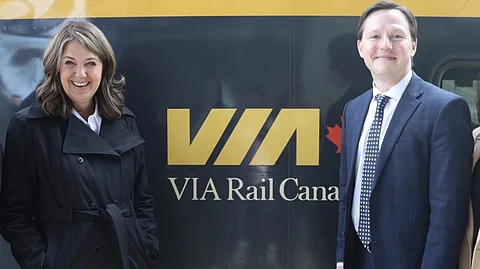

Alberta Premier Danielle Smith was recently in Quebec promoting partnerships and pushing back against so-called federal overreach with like-minded politicians.
Smith and Minister of Transportation and Economic Corridors Devin Dreeshen while in Eastern Canada met with executives from Siemens, Alto, and Alstom Canada to discuss "everything rail and to learn about best practices for passenger and high-speed rail across Canada and the world."
"Minister Dreeshen and I got to tour and ride the VIA Rail train from Montreal down to Ottawa today," wrote Smith on X. "While aboard we had the chance to meet with Via Rail, Germany’s Siemens, Canada’s Alto, and France’s Alstom Canada."
The province has launched a 15-year Passenger Rail Master Plan to transform transportation across the province, Smith announced in April 2024. The plan prioritizes a high-speed rail link between Calgary and Edmonton, with a stop in Red Deer, alongside commuter rail systems connecting downtowns to airports and suburbs in both cities.
It also explores lines to Rocky Mountain parks like Banff and Jasper. A $9-million feasibility study is underway, with results due by summer 2025. Construction could start in 2027, targeting full implementation by 2040.
A private-sector proposal, Prairie Link, led by EllisDon and AECOM, envisions a $9-billion high-speed rail line between Calgary and Edmonton, promising trains at 350-400 km/h to cut travel time to under 90 minutes. Announced in 2021 with a memorandum of understanding from the province, it remains privately funded and is under review.
Liricon Capital’s $2.6-billion hydrogen-powered rail from Calgary’s airport to Banff seeks Canada Infrastructure Bank funding, while TransPod’s hyperloop-style system, claiming 1,000 km/h speeds, faces skepticism.
Public support is strong, according to a government survey. Nearly 80% of Albertans back government involvement in a hybrid public-private model, prioritizing swift Calgary-Edmonton and commuter rail development.
A Metrolinx-style Crown corporation is planned to oversee commuter lines, with inter-city routes possibly privately operated. Proponents highlight reduced highway congestion, tourism boosts, and environmental benefits, projecting 9 million tonnes of CO2 savings over 30 years.
Critics, citing a 2014 study, question viability due to low population density, high costs, and environmental risks like wildlife disruption.
Alberta’s population, now 4.9 million and projected to reach 7.1 million by 2051, fuels optimism that modern technology and growth make rail feasible, unlike past assessments.
The plan’s fate hinges on the 2025 study, balancing hope for connectivity with pragmatic concerns over cost and scale.
The Alberta NDP, during its time in power from 2015 to 2019, did not commit to building a new high-speed rail network but showed interest in exploring the idea. In 2015, Infrastructure Minister Brian Mason mentioned reviving the possibility of a bullet train between Edmonton and Calgary, citing high traffic on the Queen Elizabeth II Highway.
